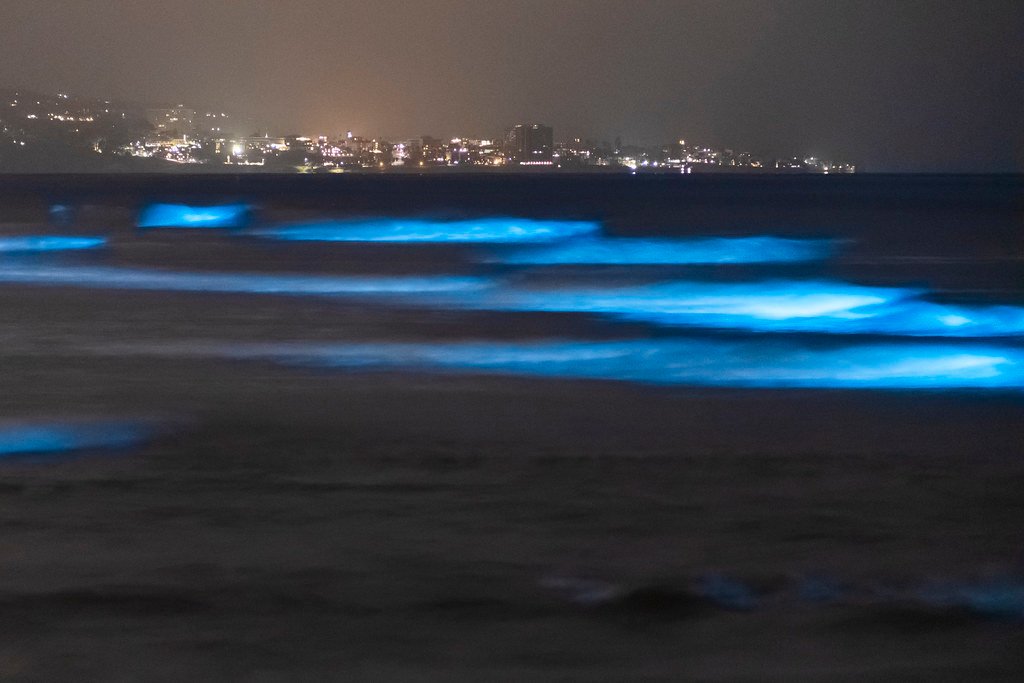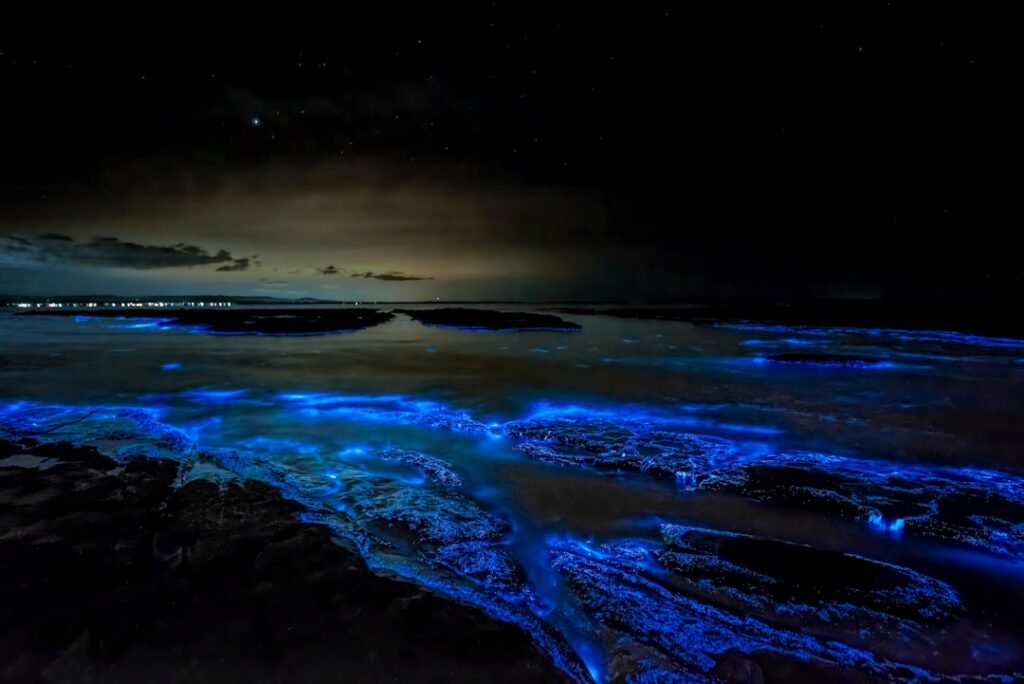The warm summer nights of Florida’s Space Coast have brought back one of nature’s most spectacular light shows. Glowing waters that look straight out of a science fiction movie are lighting up along the Sunshine State’s eastern , creating an otherworldly experience that attracts thousands of visitors each year. This magical phenomenon occurs when microscopic organisms transform ordinary coastal waters into shimmering pools of electric blue-green light.
The return of bioluminescence has tourism operators from Cocoa Beach to Titusville buzzing with excitement. After months of anticipation, the conditions are finally aligning for what experts predict will be an exceptional season of glowing waters.
What Makes Florida’s Waters Glow

Bioluminescence is the natural emission of light by living organisms. In Florida, this magical glow is caused primarily by dinoflagellates, tiny plankton that emit light when disturbed, creating a blue-green shimmer in the water. These microscopic marine organisms pack a powerful punch when it comes to creating natural light displays.
A chemical interaction between luciferin and luciferase causes bioluminescence. Light is produced when these two components combine with oxygen. Think of it like nature’s version of a glow stick, except these tiny creatures can produce this light over and over again whenever they feel threatened or disturbed.
When the organism receives pressure on its cell walls chemical reactions take place and causes the bioluminescence. Predators may shy away from the light thus the dinoflagellate avoids being eaten ( Alarm system), or the predator’s location is revealed thus it becomes prey for other organisms.
Peak Season Returns with Perfect Conditions

Bioluminescent season in Florida runs from May through early October, with peak brightness typically occurring during the hottest months – June, July, and August. This is when the water is warmest and dinoflagellate concentrations are highest. The summer of twenty twenty-five has delivered ideal conditions that scientists and tour operators say could make this one of the brightest seasons on record.
This year, the bioluminescence is expected to be especially bright during late June and throughout July due to warmer-than-usual temperatures. Pro tip: Book your tour as early as possible – weekends and new moon weeks sell out fast.
From June to October, Cocoa Beach transforms into a natural wonder thanks to bioluminescent organisms lighting up the waves. The timing couldn’t be better for summer tourists looking to add something extraordinary to their Florida vacation.
Where to Find the Best Glowing Waters

During warmer months, these organisms thrive in the Indian River Lagoon, especially near Cocoa Beach, Titusville, and Merritt Island. The Space Coast region has become the epicenter of Florida’s bioluminescent tourism industry, offering multiple launch points for nighttime adventures.
The absolutely best location to see bioluminescence in Florida is the Merritt Island National Wildlife Refuge near Titusville and the Haulover Canal. This protected area provides the perfect ecosystem for these glowing organisms to flourish without excessive human interference.
Warm, shallow waters offer these animals the perfect environment in which to flourish and show off their luminosity. The unique conditions of Florida’s coastal lagoons create an ideal breeding ground for these microscopic light shows.
Moon Phases Make All the Difference

The best nights to see the glow are during the new moon phase when the sky is darkest. A dark sky makes the glowing effect more visible, so planning your tour around the new moon dates is highly recommended. Light pollution from the moon can wash out the subtle blue-green glow that makes this experience so magical.
The new moon phase is undeniably the premier time to observe bioluminescence. During these few dark nights, when the moon retreats from the sky, an inky darkness is a canvas for nature’s luminescent art. With no moonlight to compete with, the waters come alive with sparkling blue light.
New Moon Weeks Coming Up in 2025 August: the new moon is on August 13, the best nights are August 10 to 16. Tour operators are already seeing bookings surge for these prime viewing windows.
Two Types of Glowing Creatures

In the summer months (June – September) and into Fall, we see a bioluminescence produced by a plankton called dinoflagellates. In the winter months, we see a bioluminescence produced by comb jellies. During certain months we are able to see both of them at the same time during the transitionary periods.
Most glowing marine creatures, like dinoflagellates, light up due to chemical reactions involving a molecule called luciferin and an enzyme called luciferase. But with comb jellies, the spark is triggered by physical movement or disturbance. When you scoop one gently in your palm near Haulover Canal or paddle through a group of them near Cocoa Beach, they light up because the stimulation activates light-producing cells known as photocytes.
The summer dinoflagellates create that sparkly, firework-like effect in the water that most people associate with bioluminescence. Winter’s comb jellies offer a completely different experience, glowing with a softer, more sustained light that you can literally hold in your hands.
West Coast Gets Unexpected Surprise

Anna Maria Island is currently experiencing a breathtaking display of bioluminescence along its shores. This unusual occurrence on Florida’s Gulf Coast has caught researchers and beachgoers by surprise, as bioluminescence typically appears along the Atlantic side of the state.
However, residents and beachgoers along Anna Maria Island have noticed an increase in evenings featuring blooms of bright blue. The cause of this recent rise in bioluminescent activity along the western waters of Florida is a current topic of discussion among researchers and the public alike.
This magic was captured on 9/18/2024 at Siesta Key Beach on the west coast of Florida. bioluminescence siesta key,siesta key bioluminescence,bioluminescence siesta key today,siesta key bioluminescence today,siesta key beach bioluminescence,bioluminescence,bioluminescent siesta key,bioluminescence anna maria island 2024,siesta key These sightings represent a rare treat for Gulf Coast residents who typically have to travel to the other side of the state for this natural phenomenon.
The Science Behind the Sparkle

According to “Jungle Jay,” a tour guide with BK Adventure along Florida’s east coast, these plankton create the glowing lights via a chemical reaction. “The phytoplankton release it (photoproteins) into the water and mixes with the element that’s present in the water (i.e. oxygen), and that’s what causes the chemical reaction for it to light up,” he told News 6.
In water, it is usually blue greenish. Red light is the first in the light spectrum to be absorbed in water so it does not penetrate or travel very far. Blue light travels the deepest and furthest in water. This is why bioluminescent displays in marine environments almost always appear as that distinctive blue-green color.
This technique efficiently converts virtually all energy into light rather than heat, making it a remarkable marine adaption. These tiny organisms have perfected what human technology is still trying to achieve – nearly one hundred percent efficient light production.
Tourism Industry Sees Massive Demand

Florida is among the best places in the continental U.S. where you can see bioluminescent kayaking year-round, and summer 2025 has been one of the brightest seasons yet thanks to ideal weather conditions and New Moon alignment. Florida is one of the only places in the continental U.S. where you can see bioluminescent kayaking year-round, and summer 2025 has been one of the brightest seasons yet thanks to ideal weather conditions and New Moon alignment.
This exclusive adventure is available only on new moon weeks/weekends during the summer, and bookings sell out fast. Don’t miss out! Tour operators are reporting unprecedented demand, with many weekends already completely booked through the peak season.
Check tour availability with each operator, and make sure you book your excursion in advance. They often sell out. The popularity has grown exponentially as social media showcases these magical experiences to a broader audience.
Environmental Factors Affecting Visibility

Other factors that may affect the glow are rain and storms. Rainwater can dilute the effects of the bioluminescence. Heavy rains can temporarily reduce the concentration of dinoflagellates, making the glow less visible for several days after storm events.
Another key factor that affects the brightness of the bioluminescence is the temperature of the water. The warmer the water temperature, the more intense the glow. This is why the Indian River Lagoon is excellent for bioluminescent kayaking, as it is shallow in most areas, which allows for the water temperature to heat up quickly.
Human activities, pollution, and changes in water quality can affect the abundance of dinoflagellates, so efforts to preserve the delicate balance of the ecosystem help ensure that bioluminescence continues to be a part of Florida’s natural wonders. Conservation efforts play a crucial role in maintaining these magical displays for future generations.
Photography Challenges and Tips

Your camera may not be able to capture the beauty of bioluminescence. It’s ok to put your phone down and enjoy the moment. The dim natural light makes photographing bioluminescence notoriously difficult, even with professional equipment.
Bioluminescence photography is difficult, yet the experience is unforgettable. The starry sky and bright waters offer a unique opportunity for amateur and professional photographers to capture nature’s splendor. Those who do manage to capture the phenomenon often need specialized camera settings and long exposure times.
Many visitors find that putting away their cameras and simply experiencing the moment creates more lasting memories than trying to document it. The human eye can detect the subtle glow much better than most camera sensors, making this truly a “you have to see it to believe it” experience.
Future Outlook and Conservation

The outlook for Florida’s bioluminescent displays remains positive, with researchers noting that the unique ecosystem of the Indian River Lagoon continues to support healthy populations of these glowing organisms. Climate patterns and water temperature trends suggest that conditions should remain favorable for several more months.
However, environmental pressures from development, pollution, and climate change pose ongoing threats to these delicate ecosystems. Conservation groups are working with local authorities to monitor water quality and protect the habitats that make these spectacular displays possible.
Marine biologists emphasize that maintaining the health of Florida’s coastal lagoons requires ongoing vigilance and public support. The economic impact of bioluminescent tourism provides additional incentive for protecting these natural treasures.
Conclusion

The return of bioluminescent waves represents more than just a tourist attraction. It serves as a reminder of the incredible natural wonders that still exist in our world, waiting to be discovered and appreciated. These glowing waters connect us to something larger than ourselves, offering moments of pure magic in an increasingly digital world.
The phenomenon continues to draw people from around the globe, creating memories that last a lifetime. Whether you’re a first-time visitor or a seasoned bioluminescence enthusiast, Florida’s glowing waters never fail to inspire awe and wonder. What do you think about experiencing nature’s own light show? Tell us in the comments.




